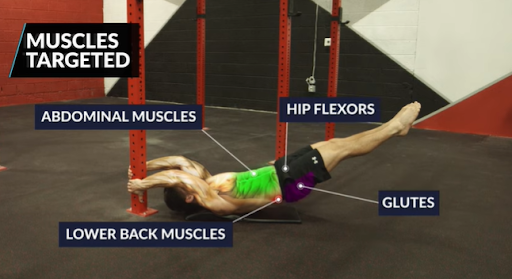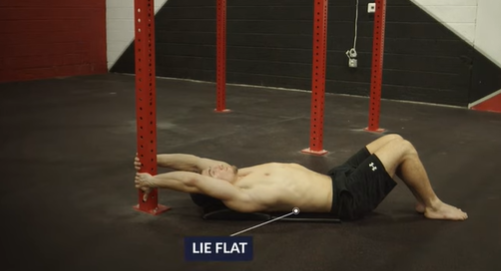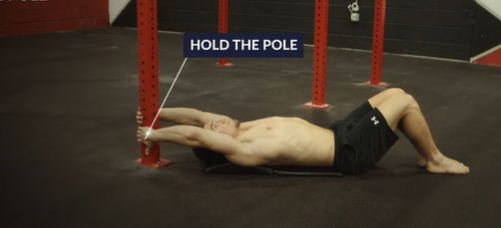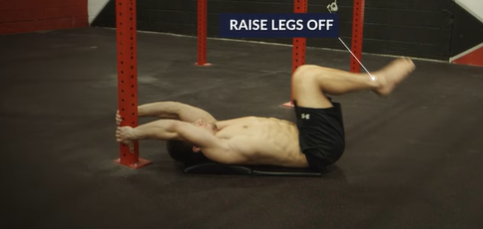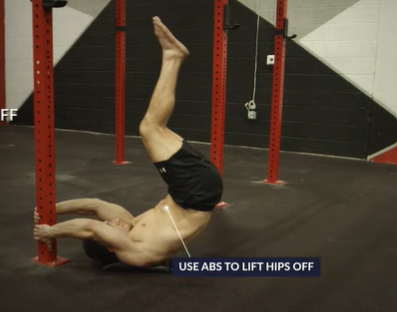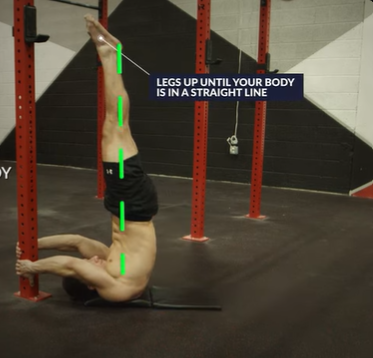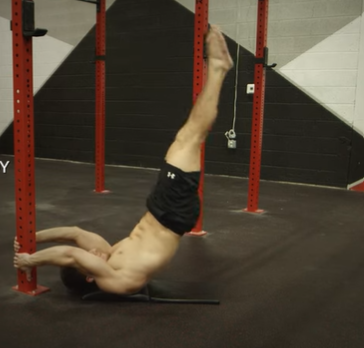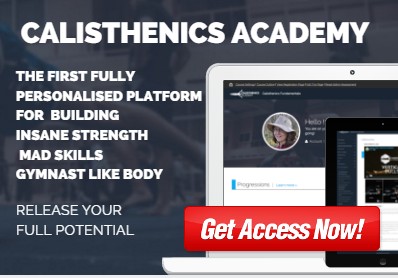Ever seen someone effortlessly suspend their body in mid-air, defying gravity with a move that seems straight out of a superhero movie? That’s the dragon flag—an awe-inspiring exercise that leaves onlookers wondering, “How on earth is that possible?”😱
The dragon flag isn’t just a flashy feat; it’s a powerhouse exercise that targets multiple muscle groups. It is a comprehensive core workout with benefits that transcend mere aesthetics.
👊But mastering this move requires more than strength—it demands control and technique. Picture yourself lying on a bench, legs lifted, body straight, then slowly lowering towards the ground before gracefully lifting back up. It’s challenging, yet immensely rewarding.
In this article, we will explore the dragon flag’s mechanics, benefits, and a step-by-step guide to conquering this iconic exercise while unlocking a steel core.
✨What is a Dragon Flag?
The dragon flag is a bodyweight exercise that primarily targets the core muscles while engaging several other muscle groups simultaneously. This exercise involves lying flat on your back on a bench or a stable surface, gripping the edge behind your head, and lifting your entire body off the bench, creating a straight line from head to toe in a controlled movement.
Beyond its physical benefits, the dragon flag cultivates mental discipline and focus due to its demanding nature. It’s not merely about executing the movement but about controlling it throughout, emphasizing the mind-muscle connection.
Renowned for its inclusion in Bruce Lee’s training routine, the dragon flag has become a symbol of supreme core strength and athleticism. Integrating it into a fitness regimen can contribute significantly to core stability, overall body strength, and improved performance across various physical activities.
Related article:
📍 Dragon Flag Progressions, Benefits, Requirements and Variations
💪Muscles Targeted
Understanding the intricate interplay of muscles engaged during exercises provides valuable insight into their effectiveness. When it comes to the dragon flag, a powerhouse among core exercises, its impact on various muscle groups is profound and comprehensive.
✊Abdominal Muscles
The star of the show, the abdominal muscles, particularly the rectus abdominis, are the primary targets during the dragon flag execution. This exercise places intense demand on the entire abdominal region, engaging both the upper and lower portions of the “six-pack” muscles.
As the body maintains a straight line throughout the movement, the rectus abdominis contracts intensely to stabilize and control the descent, effectively sculpting and strengthening the core.
If you want to work on your six-pack, check out our article How to Build 6-pack Abs: Why Most 6-pack Challenges Suck And What You Can Do Instead
✊Lower Back Muscles
While not the primary focus, the erector spinae muscles of the lower back play a crucial role in stabilizing the spine during the dragon flag. As the body maintains a rigid, straight line, these muscles engage isometrically to support the spine, preventing overarching and ensuring proper alignment. Strengthening these muscles contributes to better posture and reduced risk of lower back injuries.
Related article: Lower Back Stabilization Exercises To Reduce Lower Back Pain
✊Glutes
Though often underestimated in this exercise, the gluteal muscles play a significant role in maintaining a straight body line. They engage to provide stability and support, working synergistically with the core muscles to keep the body aligned and prevent excessive arching or sagging. While not the primary focus, the glutes contribute substantially to overall stability and control.
✊Hip Flexors
The dragon flag heavily recruits the hip flexor muscles, particularly the iliopsoas, during the lifting phase. As the legs are raised, these muscles contract dynamically to lift the lower body while also maintaining control during the descent.
Dragon flag challenges and strengthens the hip flexors, enhancing flexibility and strength in this muscle group, which is crucial for various daily activities and sports.
Understanding the diverse range of muscles engaged during the dragon flag underscores its effectiveness as a compound movement for comprehensive core strengthening. It’s not merely about the visible “six-pack” muscles but also about fortifying the deeper core muscles and surrounding stabilizers, promoting overall functional strength and stability.
Integrating the dragon flag into a core workout routine can yield remarkable results, strengthening these key muscle groups and enhancing overall physical prowess.
Why Do It: 🏆Benefits of Dragon Flags
Adding dragon flags to your workout isn’t just about a tough core exercise; it’s a way to boost your whole body. Stronger core muscles mean more than just looks—they help you do better in all kinds of activities and lower your chance of getting hurt. Whether you’re an athlete trying to improve or just want a stronger body, doing dragon flags can step up your fitness game.
✔️Improved Core Strength
At its core, the dragon flag is a supreme exercise for fortifying your midsection. It targets not only the superficial rectus abdominis but also the deeper core muscles like the transverse abdominis and obliques. This comprehensive engagement results in exceptional core strength, enhancing your ability to generate power and stability from your center.
✔️Increased Muscular Endurance
Endurance isn’t just about how long you can hold a plank; it’s about maintaining control and strength throughout movements. Dragon flags demand sustained muscular effort, requiring your core muscles to work continuously to stabilize your body.
Over time, consistent practice improves your muscular endurance, allowing you to perform other exercises and daily activities with greater ease and efficiency.
✔️Stronger Abdominal Muscles
Want a strong, defined midsection? The dragon flag is your ticket. By uniquely challenging your abs, this exercise stimulates muscle growth and development. The constant tension and controlled movement throughout the exercise effectively sculpt and strengthen the abdominal muscles, promoting that coveted six-pack appearance.
If you want to build stronger abdominal muscles check out our article on 5 Best Calisthenics Exercises for Your Abs Strength and Muscle
✔️Enhanced Body Control and Stability
The dragon flag is the epitome of control. To execute it properly, you need not just strength but finesse and coordination. As you progress in mastering this exercise, you’ll notice improvements in your overall body control and stability. Your ability to maintain a straight line while lifting and lowering your body fosters a deeper understanding of body mechanics and control.
🤔 How to Do It?
Mastering the dragon flag demands not just strength but precise control and technique. Let’s break down each step in detail to help you execute this challenging yet rewarding exercise effectively:
Starting position:
1. Lie Flat: Begin by lying flat on your back, preferably on a floor or a bench. Ensure your entire back is in contact with the floor/bench and your head is positioned comfortably.
2. Hold the Pole: Grip the edge of the bench or any secure object behind your head firmly. Your hands should grasp the bench for stability throughout the exercise. Ensure a strong, secure grip to support your upper body.
Movement Execution:
1. Raise Legs Off: Initiate the movement by lifting your legs off. Keep them together and straight, engaging your core muscles to start the lift. This action will naturally raise your hips slightly.
2. Use Abs to Lift Hips Off: Engage your abdominal muscles intensely as you continue lifting your legs. Use the strength of your core, especially the lower abs, to lift your hips further off the bench. Focus on maintaining control and a slow, deliberate movement.
3. Legs Up Until Your Body is in a Straight Line: Continue lifting your legs until your body forms a straight line from head to heels. Your entire body should be hovering above the bench, supported mainly by your upper back and shoulders. Keep your core tight and avoid arching your back excessively.
4. Slowly Lower Your Body Back Down: Once you’ve reached the top position with your body straight, reverse the movement slowly and in a controlled manner. Lower your body back down to the floor or bench, maintaining tension in your core throughout the descent.
5. Breathe Throughout the Exercise: Remember to breathe steadily and rhythmically throughout the entire movement. Inhale as you prepare to lift your legs and exhale as you exert effort to raise your body. Consistent breathing helps maintain focus and control.
Related article: 📍The Proper Way to Breath during Exercise to Maximize Performance
Check out this YouTube video on dragon flag
☝️ Common Mistakes
Mastering the dragon flag can be challenging, and certain common mistakes can hinder progress or even lead to injury. Here are some pitfalls to watch out for when performing dragon flags:
- Overarching or Sagging Back: Maintaining a straight line from head to heels is crucial. Arching your back excessively or allowing it to sag disrupts the engagement of core muscles and can strain the lower back.
- Relying Too Much on Momentum: Using momentum to lift your legs rather than relying on core strength diminishes the exercise’s effectiveness. Focus on controlled, deliberate movements throughout.
- Incorrect Hand Position or Grip: Inadequate or unstable hand positioning, especially when holding a pole or support, can compromise stability. Ensure a secure grip to support your upper body properly.
- Lifting Hips Too High: While lifting your legs, avoid excessively raising your hips, as this can shift the focus away from the core and increase strain on the shoulders and upper back.
- Not Breathing Properly: Neglecting proper breathing can disrupt your rhythm and stability. Remember to breathe steadily and coordinate your breath with each phase of the movement.
- Starting with Full Reps Too Soon: Attempting full dragon flags without adequate strength and control can lead to poor form. Begin with partial reps or bent-knee variations to build strength and technique gradually.
- Lack of Core Engagement: Failing to engage your core muscles adequately throughout the movement reduces the exercise’s effectiveness. Focus on contracting your abs and maintaining tension in your core.
- Ignoring Body Alignment: Straying from a straight body line compromises the exercise. Ensure proper alignment from head to heels and avoid any deviations during the movement.
- Skipping Warm-Up: Not warming up properly can increase the risk of injury, especially with an advanced exercise like the dragon flag. Warm up your core and surrounding muscles adequately before attempting this exercise.
- Pushing Beyond Limits: It’s essential to know your limits and not push too hard too soon. Gradually progress in difficulty and intensity to prevent strain or injury.
Being mindful of these common mistakes and focusing on proper form and technique can help you maximize the benefits of the dragon flag while minimizing the risk of injury. Consistent practice with attention to detail will contribute to mastering this challenging core exercise.
🧐Frequently Asked Questions:
🔎 Are dragon flags suitable for beginners?
Dragon flags are an advanced core exercise that requires significant strength and control. Beginners might find them challenging initially. It’s advisable to start with simpler core exercises and gradually progress to dragon flags as strength and technique improve.
🔎 How can I progress to doing a full dragon flag?
Begin by practicing partial reps or bent-knee variations to build strength and familiarity with the movement. As you gain strength, gradually extend your legs further until you can perform a full dragon flag with control and proper form.
🔎 Can I perform dragon flags without equipment?
Yes, dragon flags can be performed without specific equipment. Instead of using a bench or pole, lie flat on the floor and grip a stable object (such as a sturdy chair leg or heavy furniture) behind your head for support during the exercise.
🔎 How many repetitions and sets should I do?
Start with a manageable number of repetitions, aiming for quality over quantity. Begin with 3-5 repetitions per set and gradually increase as your strength improves. Performing 2-3 sets with proper form is sufficient for most individuals.
🔎 What muscles do dragon flags primarily target?
Dragon flags primarily target the core muscles, including the rectus abdominis, transverse abdominis, and obliques. Additionally, they engage the hip flexors, glutes, and lower back muscles to stabilize the body throughout the movement.
🔎 Are dragon flags risky for the lower back?
When performed with proper form and controlled movements, dragon flags are a safe exercise. However, individuals with existing lower back issues should approach this exercise cautiously. Engage your core muscles to maintain proper alignment and avoid overarching the back to minimize strain on the lower back. As with any exercise, consulting a fitness professional or healthcare provider for guidance is recommended if you have concerns about your lower back.
💥Conclusion
The dragon flag is not for the faint of heart, but its rewards in core strength, stability, and overall athleticism make it worth the effort.
Remember, like any challenging exercise, mastering the dragon flag takes time, patience, and consistent practice. Start gradually, focus on form, and gradually increase the difficulty to reap the full benefits of this exceptional core exercise.
Curious about your fitness strengths and areas for improvement? Take the first step toward unlocking your full potential with a free assessment from The Movement Athlete. Discover personalized insights, tailored strategies, and a roadmap to elevate your fitness game. Don’t just wonder—empower yourself to move better, stronger, and smarter.

